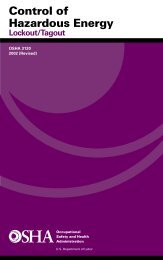Toxic Chemical Release Inventory Reporting Forms and Instructions
Toxic Chemical Release Inventory Reporting Forms and Instructions
Toxic Chemical Release Inventory Reporting Forms and Instructions
You also want an ePaper? Increase the reach of your titles
YUMPU automatically turns print PDFs into web optimized ePapers that Google loves.
Example 14: Container Residue<br />
<strong>Instructions</strong> for Completing Part II of EPA Form R<br />
You have determined that a Form R for an EPCRA section 313 chemical must be submitted. The facility purchases <strong>and</strong> uses<br />
one thous<strong>and</strong> 55-gallon steel drums that contain a 10% solution of the chemical. Further, it is assumed that the physical<br />
properties of the solution are similar to water. The solution is pumped from the drums directly into a mixing vessel <strong>and</strong> the<br />
“empty” drums are triple-rinsed with water. The rinse water is indirectly discharged to a POTW <strong>and</strong> the cleaned drums are sent<br />
to a drum reclaimer.<br />
In this example, it can be assumed that all of the residual solution in the drums was transferred to the rinse water. Therefore,<br />
the quantity transferred to the drum reclaimer should be reported as “zero.” The annual quantity of residual solution that is<br />
transferred to the rinse water can be estimated by multiplying the mean weight percent of residual solution remaining in water<br />
from pumping a steel drum (2.29% from the preceding table, "Summary of Residue Quantities From Pilot-Scale Experimental<br />
Study") by the total annual weight of solution in the drum (density of solution multiplied by drum volume). If the density is not<br />
known, it may be appropriate to use the density of water (8.34 pounds per gallon):<br />
(2.29%) × (8.34 pounds/gallon) × (55 gallons/drum) × (1,000 drums) = 10,504 pounds solution<br />
The concentration of the EPCRA section 313 chemical in the solution is only 10%.<br />
(10,504 pounds solution) × (10%) = 1,050 pounds<br />
Therefore, 1,050 pounds of the chemical are transferred to the POTW.<br />
If you transfer the EPCRA section 313 chemical in wastes to an<br />
off-site facility for distinct <strong>and</strong> multiple purposes, you must<br />
report those activities for each off-site location, along with the<br />
quantity of the reported EPCRA section 313 chemical<br />
associated with each activity. For example, your facility<br />
transfers a total of 15,000 pounds of toluene to an off-site<br />
location that will use 5,000 pounds for the purposes of energy<br />
recovery, enter 7,500 pounds into a recovery process, <strong>and</strong><br />
dispose of the remaining 2,500 pounds. These quantities <strong>and</strong><br />
the associated activity codes must be reported separately in<br />
Section 6.2. (See Figure 4 for a hypothetical Section 6.2<br />
completed for two off-site locations, one of which receives the<br />
transfer of 15,000 pounds of toluene as detailed.) If you have<br />
fewer than four total transfers in Section 6.2 Column A (see<br />
examples in Figure 4), an NA should be placed in Column A of<br />
the first unused row to indicate the termination of the sequence.<br />
If all four rows are used, there is no need to terminate the<br />
sequence. If there are more than four total transfers, re-enter the<br />
name of the off-site location, address, etc. in the next row<br />
(6.2.2) <strong>and</strong> then you should enter NA when the sequence has<br />
terminated if there are fewer than 8 (i.e. anytime there are fewer<br />
than 4 transfers listed in a Section 6.2 block, an NA should be<br />
used to terminate the sequence).<br />
Do not double or multiple count amounts transferred off-site.<br />
For example, when a reported EPCRA section 313 chemical is<br />
sent to an off-site facility for sequential activities, you should<br />
report the final disposition of the toxic chemical.<br />
6.2b Column B: Basis of Estimate<br />
You must identify the basis for your estimates of the quantities<br />
of the reported EPCRA section 313 chemical in waste<br />
transferred to each off-site location. Enter one of the following<br />
letter codes that applies to the method by which the largest<br />
percentage of the estimate was derived.<br />
M— Estimate is based on monitoring data or measurements<br />
for the EPCRA section 313 chemical as transferred to<br />
an off-site facility.<br />
C— Estimate is based on mass balance calculations, such<br />
as calculation of the amount of the EPCRA section<br />
313 chemical in streams entering <strong>and</strong> leaving process<br />
equipment.<br />
E— Estimate is based on published emission factors, such<br />
as those relating release quantity to throughput or<br />
equipment type (e.g., air emission factors).<br />
O— Estimate is based on other approaches such as<br />
engineering calculations (e.g., estimating volatilization<br />
using published mathematical formulas) or best<br />
engineering judgment. This would include applying<br />
an estimated removal efficiency to a waste stream,<br />
even if the composition of the stream before treatment<br />
was fully identified through monitoring data.<br />
<strong>Toxic</strong>s <strong>Release</strong> <strong>Inventory</strong> <strong>Reporting</strong> <strong>Forms</strong> <strong>and</strong> <strong>Instructions</strong> 49
















